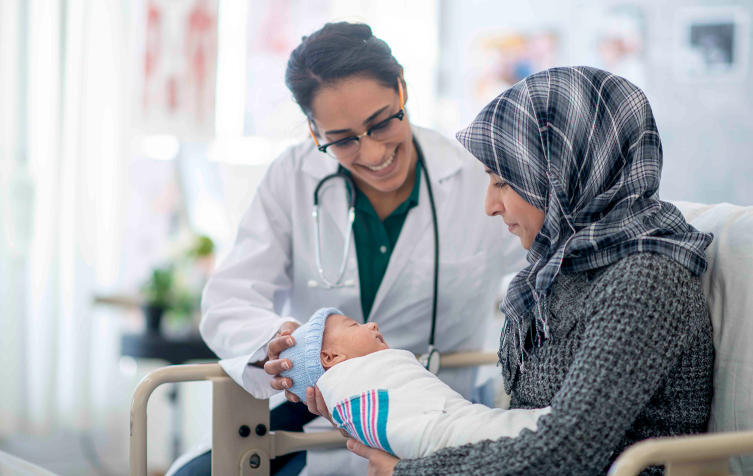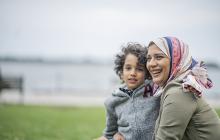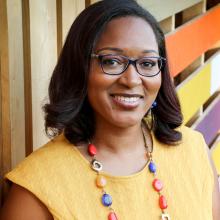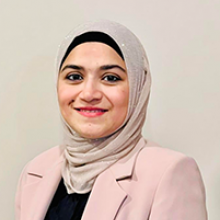Research Insights on Health Equity for Afghan Refugees

Backed by the AIR Equity Initiative, AIR is working with partners to help multisector organizations collaborate more effectively and advance health equity for Afghan refugees. AIR’s partners on this project, Church World Service (CWS) and the Muslim Community Center Medical Clinic (MCC-Medical Clinic), are instrumental voices on the project’s leadership team.
In this Q&A, AIR researchers Trenita Childers and Maliha Ali share early insights from the Health Equity for Afghan Refugees (HEAR) project in the District of Columbia, Maryland, and Virginia region. Findings from the project could help inform approaches that improve long-term health and well-being for refugees.
Q. Tens of thousands of Afghan refugees came to the U.S. via Operation Allies Welcome. What do we know about how the resettlement process is going?
Childers: At a systems level, resettlement happens in phases. Typically, there’s a waiting period during which new arrivals receive orientation and information about the culture and practices of the country where they’re going. Then, once people arrive, the first three months of resettlement includes government funding to assist new arrivals with basic needs such as food, housing, employment, and school enrollment for children. Since Afghan refugees were evacuated under emergency circumstances, they did not receive orientation before they arrived. Assistance went beyond the 90-day period typically designated for resettlement agencies to help with these supports. But there were challenges accessing benefits, due to the large number of refugees relative to the capacity at resettlement agencies.
We discuss what’s happening in their daily lives using an asset-based lens, which means we focus on strengths rather deficits. We want to highlight their resilience, resourcefulness, and community support, not just their difficulties and trauma.
Afghan refugees have a wide range of backgrounds, and the resettlement experience can look very different based on individuals’ levels of education, proficiency in English, health status, and legal status upon arrival. For example, one participant in our project has a college degree and learned to speak English within a few months of arriving. One year since the evacuation, she now has a job, stable housing, and a driver’s license. She has built new social networks by connecting to a local mosque and getting to know her neighbors.
Ali: Another participant in our study is a grandmother in her 50s. She arrived with her three school-aged grandchildren, whose parents were left behind at the airport in Afghanistan. She has a disability that prevents her from working, she only speaks Dari, and with rental assistance from the resettlement program phasing out, she struggles to make ends meet. This context is important for understanding what Afghan refugees are experiencing. Many live with a base-level, day-to-day anxiety as they try to integrate and build a new life here, without knowing how long the resettlement process will be.
Regarding legal status, most Afghans who arrived are humanitarian parolees, which is a temporary status with no clear path to permanent residence. This status puts Afghan arrivals in a form of limbo— they have work authorization that enables them to work, but when their temporary legal status expires, so does their ability to remain employed and financially sustain themselves. Language and transportation barriers also contribute to high levels of isolation and loneliness among new arrivals. Many are still afraid for friends and family left behind in Afghanistan.
Q. Many service providers are stretched thin as they work to meet the needs of Afghan refugees. What has it been like to engage stakeholders in this project?
Researchers conducting ethnographic studies collect data through observations, interviews, interactions, and/or surveys to learn more about the daily lives of individuals or groups in their own environment. In the HEAR project, our modified ethnographic approach includes virtual engagement with Afghan refugees in the study; longitudinal, in-depth interviews; and ongoing participant reflection.
Ali: We are helping a heterogenous group of 11 resettlement agencies, community organizations, and government agencies identify and align around a shared purpose to serve Afghan newcomers. It has been a true learning experience.
Early in the project, we dedicated time to learn about the different organizations, their roles in resettlement, and the challenges they experience. Through interviews and focus groups, we heard from 26 people engaged in numerous aspects of resettlement. We listened to lawyers, physicians, and leadership and program staff from government agencies, resettlement agencies, medical clinics, advocacy organizations, and many Afghan-led, and faith-based community organizations. This helped us design a learning network that could be responsive to participants’ interests and concerns. HEAR Learning Network participants have shared with us that they’ve wanted to do this for a long time.
Some organizations are more or less responsive depending on their bandwidth, and we’ve learned that we have to be flexible in our engagement approach. For example, when extending invitations to participate in the HEAR Network, we spoke with people over the phone in addition to sending email invitations to create more warmth in the process.
Q: The HEAR project includes ethnographic interviews with Afghan refugees. How have you incorporated culturally responsive research practices in this data collection process?
Childers: We’ve taken a modified ethnographic approach, which includes brief monthly check-ins and longer guided interviews with eight Afghan refugees who are at various stages of their resettlement process. We discuss what’s happening in their daily lives using an asset-based lens, which means we focus on strengths rather deficits. We want to highlight their resilience, resourcefulness, and community support, not just their difficulties and trauma.
We’ve partnered with two Afghan community ambassadors who are also refugees and speak the languages that the participants speak—Dari and Pashto—to conduct monthly check-ins, connect participants to local resources, and serve as a source of social support. Listening to Afghan refugees’ voices as part of the HEAR project complements our efforts to listen to the voices of the organizations serving them.
Q: How might the HEAR project provide insights for improving health and well-being in the resettlement landscape?
When refugees integrate into U.S. communities, health equity should be at the fore of resettlement priorities, since refugees’ social and health needs become part of state and local constituencies’ needs, broadly impacting health and well-being of all communities.
Childers: This project offers us the chance to closely examine social determinants of health, or the conditions in which people are born, grow, live, work, and age that shape health and occur outside of clinical care. Such factors include adequate housing, employment, education, and neighborhood resources, among others. For Afghan refugees, we’re seeing how the social factors in their resettlement experience influence mental and physical health. Most refugees are eligible for Medicaid, so their experiences interacting with the health care system can help us learn about issues with access to timely care, mental health treatment, culturally competent and trauma-informed care, and costs of chronic disease management.
Ali: What’s also important is that the resettlement landscape offers a unique window of opportunity to advance health equity for all refugees. It’s not often that we see stakeholders from so many different areas coming together for a shared purpose of community well-being. In refugee resettlement, that opportunity arises each time a group of refugees arrives in the country. It’s a really promising chance to align systems around community priorities. But people tend to look at resettlement as a foreign policy or state government issue and miss out on the health equity implications. The HEAR project is creating a framework for cross-systems collaboration that will benefit Afghan refugees and, hopefully, other refugee groups as well.
Refugee resettlement is not a flash-in-the-pan issue. With concerns such as climate change and global instability, it’s increasingly important to plan for refugee health and well-being. When refugees integrate into U.S. communities, health equity should be at the fore of resettlement priorities, since refugees’ social and health needs become part of state and local constituencies’ needs, broadly impacting health and well-being of all communities.


